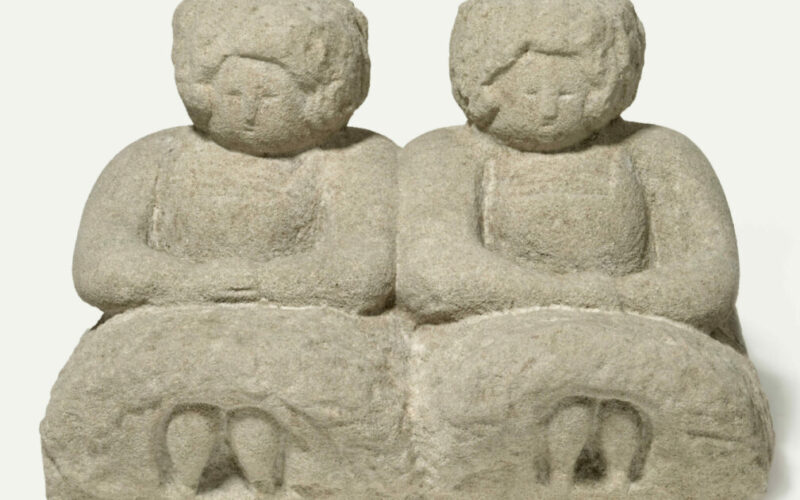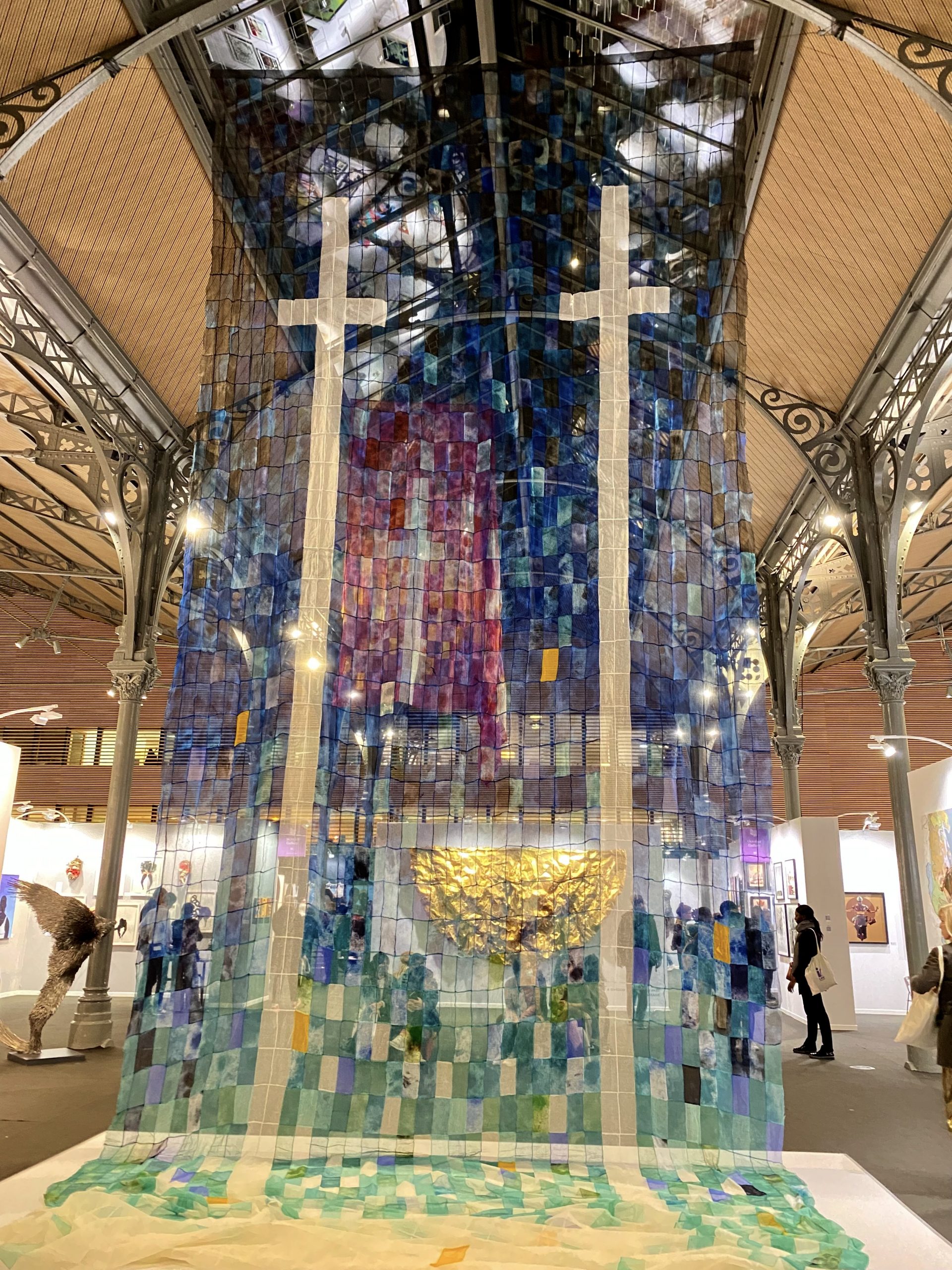Above: William Edmondson. Mary and Martha, c. 1931–37. Collection of KAWS. Photo © Bill Jacobson Studio.
In summer 2023, the Barnes Foundation will present William Edmondson: A Monumental Vision, the first major East Coast exhibition dedicated to the work of self-taught American sculptor William Edmondson (c. 1874–1951) in decades. Though Edmondson was considered one of the most important Black artists of the American South in the early 20th century, in-depth attention to his work has been sporadic. Co-curated by the Barnes’s James Claiborne, Curator of Public Programs, and Nancy Ireson, Deputy Director for Collections and Exhibitions & Gund Family Chief Curator, this exhibition sheds new light on Edmondson’s practice and artistry and explores the artist and his oeuvre within the context of African American social history.
Major support for William Edmondson: A Monumental Vision has been provided by The Pew Center for Arts & Heritage. Additional support is provided by Comcast NBCUniversal, the Wyeth Foundation for American Art, and the Henry Moore Foundation. This exhibition is on view in the Roberts Gallery from June 25 through September 10, 2023.
Edmondson made carving his vocation around 1932, having previously worked as a hospital orderly in Nashville, Tennessee. Inspired by a vision—described by the artist as a divine calling—he developed a career making headstones for the city’s Black cemeteries. Soon he expanded his repertoire to include freestanding figurative sculptures, depicting nurses, teachers, angels, and preachers. Following a solo exhibition at New York’s Museum of Modern Art (MoMA) in 1937—the institution’s first show dedicated to a Black artist—he increasingly found buyers beyond his immediate community, attracting the attention of East Coast intellectuals and collectors. As Edmondson found fame beyond Nashville, media coverage of the artist played into racialized stereotypes about the Southern Black experience, with many journalists framing Edmondson’s sculptures as the work of a “modern primitive.” Such readings may have been encouraged by how white photographers, including Louise Dahl-Wolfe and Edward Weston, captured the artist at work in the 1930s and 1940s.
More than 80 years later, William Edmondson: A Monumental Vision presents over 60 works by Edmondson. Acknowledging the complexities of his early critical reception, the Barnes exhibition also presents a selection of Dahl-Wolfe’s and Weston’s photographs, not as documentary evidence of Edmondson’s practice but as independent works of art that at once celebrate and romanticize their subject. The show reassesses the artist as more than a passive actor in an unfolding drama—a self-taught sculptor “discovered” by white patrons and institutions—and explores how Edmondson’s identity and position within history influenced his life and work.
This exhibition also examines the complex relationship between Black cultural production and the American museum. To further investigate this theme, acclaimed visual and movement artist Brendan Fernandes—who works at the intersections of dance and visual art, addressing cultural displacement, migration, labor, and queer subjectivity—has been commissioned to create a new work, which will activate the exhibition on select dates throughout the summer. In Returning to Before, Fernandes, a classically trained dancer, has choreographed a piece that will employ the techniques of ballet and modern and contemporary dance to respond to and interact with Edmondson’s sculptures. In considering the guiding role that spirituality plays in both his own work and that of Edmondson, Fernandes prompts audiences to interrogate a museum’s capacity to serve as a space for spiritual creative expression. He and exhibition designer Yaumu Huang have created a contemplative display space—constructed as a kind of altar or memorial—that includes a Jacquard tapestry designed by Fernandes. A corps of dancers will activate this environment, evoking, as Fernandes describes, “the innate choreographic nature of Edmondson’s own sculpture making, chiseling, and carving.” Through this collective movement of the dancers and audiences within the Roberts Gallery, the museum space becomes a place for communal homage to the artistic and spiritual legacy of Edmondson.
Returning to Before will begin on July 14, with an evening performance and conversation featuring Brendan Fernandes. Following the opening, performances will take place in the exhibition space on Saturdays from July 15 through September 9 at noon and 2 pm. (Included with admission.)
“Across our programs, we extend and grow Dr. Albert C. Barnes’s commitment to racial equality, social justice, and education. William Edmondson: A Monumental Vision is representative of our commitment to presenting underresearched and underrepresented artists, and to demonstrating the contemporary relevance of historic works of art,” says Thom Collins, Neubauer Family Executive Director and President at the Barnes. “This exhibition expands our understanding of William Edmondson as a major figure in American art and marks the first in a series of collaborations that elevate the role of performance in exhibitions. Recognizing the interpretive potential for performance to build new pathways into historical art, we are expanding and deepening our program, developing our capacity for collaboration and placing performance at the heart of exhibition development.”
Arranged thematically, the works in this exhibition are on loan from museums and private collections across the US, including many from the Cheekwood Estate and Gardens in Nashville, which holds the largest collection of Edmondson’s work. In addition to the animals, angels, and other religious iconography Edmondson was known for, exhibition highlights include:
- Ancient Egyptian Couple (limestone sculpture, c. 1940), from the Museum of Everything, London
- Edmondson’s only sculpture of a male nude, made for Sidney Mttron Hirsch: Reclining Man (limestone sculpture, date unknown), from Cheekwood Estate and Gardens, Nashville, gift of Michael LeBeck in memory of Sidney Mttron Hirsch
- Important works from the collection of KAWS, including Untitled (Angel) (c. 1940), Untitled (Seated Girl) (date unknown), and Untitled (Crucifix) (c. 1935–45), all limestone sculptures
- Mermaid (limestone sculpture, c. 1932–41), the collection of Robert and Katharine Booth
- 12 photographs of William Edmondson by Louise Dahl-Wolfe (c. 1895–1989)
- A rare carving of Eleanor Roosevelt (limestone sculpture, c. 1940), from a private collection
“Recognizing the gaps in Dr. Barnes’s collection, we focus on presenting the voices and work of women and artists of color in our exhibition program,” says co-curator Nancy Ireson. “Through this exhibition, we seek to recontextualize William Edmondson, reinstating the importance of community in his work and rejecting narratives that oversimplify his life and practice. As we highlight Edmondson’s position in art history, questions about equity in the cultural sector arise that still resonate today, making the exhibition a space for important discussions.”
“This exhibition is our first to draw a holistic connection between the Barnes’s performance and exhibition programs,” says co-curator James Claiborne. “By bringing Brendan Fernandes’s performance directly into the exhibition, we hope to create new and compelling points of entry for audiences and engage visitors in an active dialogue about multifaceted Black experiences across time and place. We are excited to showcase Fernandes’s new work, Returning to Before, and witness how it brings Edmondson’s sculptures, and the stories they tell, to life in new ways.”
ABOUT THE ARTISTS
William Edmondson (c. 1874–1951) made carving his vocation around 1932, having previously worked as a hospital orderly in Nashville, Tennessee. Inspired by a vision—described by the artist as a divine calling—Edmondson began to carve gravestones, freestanding figurative sculpture, and garden ornaments. These pieces, distinctive for their clean lines and succinct expression of character, soon attracted the attention of curators and collectors, and in 1937, Edmondson became the first Black artist to have a solo exhibition at the Museum of Modern Art, New York.
Brendan Fernandes (b. 1979, Nairobi, Kenya) is an internationally recognized Canadian artist working at the intersection of dance and visual arts. Currently based out of Chicago, Fernandes addresses issues of race, queer culture, migration, protest, and other forms of collective movement in his work. Always looking to create new spaces and new forms of agency, his projects take on hybrid forms: part ballet, part queer dance hall, part political protest, always rooted in collaboration and fostering solidarity. Fernandes is a graduate of the Whitney Independent Study Program (2007) and a recipient of a Robert Rauschenberg Fellowship (2014). In 2010, he was shortlisted for the Sobey Art Award and is the recipient of a prestigious 2017 Canada Council New Chapters grant. Fernandes is also the recipient of the Artadia Award (2019), a Smithsonian Artist Research Fellowship (2020), and a Louis Comfort Tiffany Foundation grant (2019). His projects have shown at the 2019 Whitney Biennial, New York; the Solomon R. Guggenheim Museum, New York; the Museum of Modern Art, New York; the Getty Museum, Los Angeles; the National Gallery of Canada, Ottawa; and MAC Montreal, among others. He is currently an assistant professor at Northwestern University and represented by Monique Meloche Gallery in Chicago. Recent and upcoming projects include performances and solo presentations at the Noguchi Museum, New York; Munch Art Museum, Oslo; the Richmond Art Gallery, British Columbia; and the DR Vocal Ensemble, Copenhagen.










